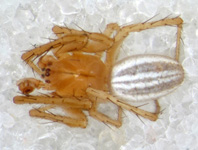Abstract
The Lepidoptera of North America Network, or LepNet, is a digitization effort recently launched to mobilize biodiversity data from 3 million specimens of butterflies and moths in United States natural history collections (http://www.lep-net.org/). LepNet was initially conceived as a North American effort but the project seeks collaborations with museums and other organizations worldwide. The overall goal is to transform Lepidoptera specimen data into readily available digital formats to foster global research in taxonomy, ecology and evolutionary biology.
References
Als, T.D., Vila, R., Kandul, N.P., Nash, D.R., Yen, S.-H., Hsu, Y.-F., Mignault, A.A., Boomsma, J.J. & Pierce, N.E. (2004) The evolution of alternative parasitic life histories in large blue butterflies. Nature, 432, 386–390.
https://doi.org/10.1038/nature03020Braby, M.F., Vila, R. & Pierce, N.E. (2006) Molecular phylogeny and systematics of the Pieridae (Lepidoptera: Papilionoidea): higher classification and biogeography. Zoological Journal of the Linnaean Society, 147, 239–275.
https://doi.org/10.1111/j.1096-3642.2006.00264.xCanfield, M.R., Green, E., Moreau, C.S., Chen, N. & Pierce, N.E. (2008) Exploring phenotypic plasticity and biogeography in emerald moths: a phylogeny of the genus Nemoria (Lepidoptera: Geometridae). Molecular Phylogenetics and Evolution, 49, 477–487. https://doi.org/10.1016/j.ympev.2008.07.003
Cobb, N.E., Seltmann, K.C. & Franz, N.M. (2016) The current state of arthropod biodiversity data: addressing impacts of global change. Available from: http://www.lep-net.org/wp-content/uploads/2017/01/Cobb-Seltmann-Franz_-ICE_2016-sept2-1.pdf (accessed 15 January 2017)
Ehrlich, P.R. & Raven, P.H. (1964) Butterflies and plants: a study in coevolution. Evolution, 18, 586–608.
https://doi.org/10.2307/2406212Gries, C., Gilbert, E.E. & Franz, N.M. (2014) Symbiota – a virtual platform for creating voucher-based biodiversity information communities. Biodiversity Data Journal, 2, e1114.
https://doi.org/10.3897/bdj.2.e1114Janz, N. (2011) Ehrlich and Raven revisited: mechanisms underlying codiversification of plants and enemies. Annual Review of Ecology, Evolution and Systematics, 42, 1–512.
https://doi.org/10.1146/annurev-ecolsys-102710-145024Hamback, P.A., Summerville, K.S., Steffan-Dewenter, I., Krauss, J., Englund, G. & Crist, T.O. (2007) Habitat specialization, body size, and family identity explain lepidopteran density-area relationships in a cross-continental comparison. Proceedings of the National Academy of Sciences, 104, 8368–8373.
https://doi.org/10.1073/pnas.0611462104Kawahara, A.Y. & Pyle, R.M. (2012) An appreciation for the natural world through collecting, owning and observing insects. In: Lemelin, R.H. (Ed.), The Management of Insects in Recreation and Tourism. Cambridge University Press, Cambridge, pp. 138–152.
https://doi.org/10.1017/cbo9781139003339.011Menken, S.B.J., Boomsma, J.J. & van Nieukerken, E.J. (2009) Large-scale evolutionary patterns of host plant associations in Lepidoptera. Evolution, 64, 1098–1119.
https://doi.org/10.1111/j.1558-5646.2009.00889.xMonteiro, A. & Pierce, N.E. (2001) Phylogeny of Bicyclus (Lepidoptera: Nymphalidae) inferred from COI, COII, and EF-1alpha gene sequences. Molecular Phylogenetics and Evolution, 18, 264–281.
https://doi.org/10.1006/mpev.2000.0872Ockinger, E., Schweiger, O., Crist, T.O. & Bommarco, R. (2010) Life-history traits predict species responses to habitat area and isolation: a cross-continental synthesis. Ecology Letters, 13, 969–979.
https://doi.org/10.1111/j.1461-0248.2010.01487.xRoe, A.D., Weller, S.J., Baixeras, J., Brown, J., Cummings, M.P., Davis, D.R., Kawahara, A.Y., Parr, C.S., Regier, J.C., Rubinoff, D., Simonsen, T.J., Wahlberg, N. & Zwick, A. (2009) Evolutionary framework for Lepidoptera model systems. In: Goldsmith, M.R. (Ed.), Genetics and Molecular Biology of Lepidoptera. CRC Press, Boca Raton, pp. 1–24.
https://doi.org/10.1201/9781420060201-c1Solak, E. & Cakir, R. (2015). Exploring the effect of materials designed with augmented reality on language learners’ vocabulary learning. The Journal of Educators Online, 13 (2), 50–72.
https://doi.org/10.9743/jeo.2015.2.5Talavera, G., Lukhtanov, V.A., Pierce, N.E. & Vila, R. (2013) Establishing criteria for higher-level classification using molecular data: the systematics of Polyommatus blue butterflies (Lepidoptera, Lycaenidae). Cladistics, 29, 166–192.
https://doi.org/10.1111/j.1096-0031.2012.00421.xvan Horn, G., Branson, S., Farrell, R., Haber, S., Barry, J., Ipeirotis, P., Perona, P. & Belongie, S. (2015) Building a bird recognition app and large scale dataset with citizen scientists: the fine print in fine-grained dataset collection. Computer Vision and Pattern Recognition (CVPR). Available from: https://vision.cornell.edu/se3/projects/visipedia/ (accessed 15 January 2017)
van Nieukerken, E.J. (2011) Order Lepidoptera Linnaeus, 1758. In: Zhang, Z.-Q. (Ed.), Animal biodiversity: an outline of higher classification and survey of taxonomic richness. Zootaxa, 3148, 212–221.
Vila, R., Bell, C.D., Macniven, R., Goldman-Huertas, B., Ree, R.H., Marshall, C.R., Balint, Z., Johnson, K., Benyamini, D. & Pierce, N.E. (2011) Phylogeny and palaeoecology of Polyommatus blue butterflies show Beringia was a climate-regulated gateway to the New World. Proceedings of the Royal Society B, 278, 2737–2744.
https://doi.org/10.1098/rspb.2010.2213Wagner, D.L. (2001) Moths. In: Levin, S.A. (Ed.), Encyclopedia of Biodiversity. Academic Press, San Diego, pp. 249–270.
https://doi.org/10.1016/b0-12-226865-2/00201-7

